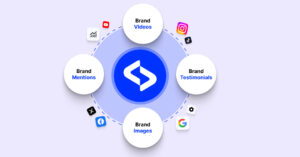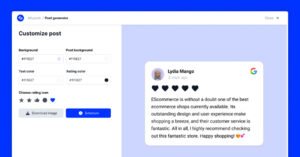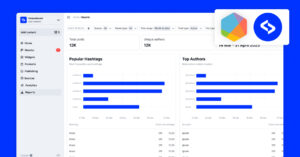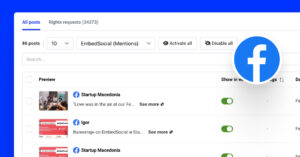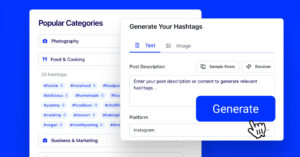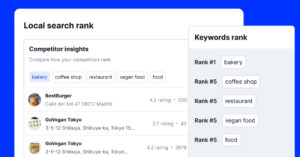Conducting a marketing survey is one of the most affordable and effective ways to do profound research and collect real customer feedback, which is considered to be one of the key elements of every successful business/product/service.
Long gone are the days when “gut feelings” and making assumptions were good enough. Nowadays, marketing based on data is the foundation to making important and effective decisions regardless of how big or small your business is.
Surveys and the use of all sorts of marketing forms are just part of any marketing team’s DNA. So, having them embedded in your marketing activities comes by default.
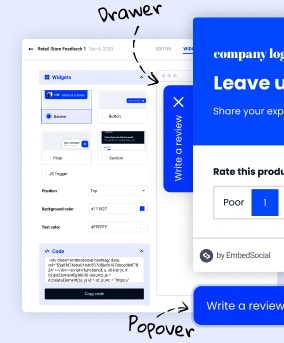
Build all your web forms for free
EmbedForms is the only form builder you will ever need to capture web leads, create surveys, or collect feedback on your website.
All PRO features | Cancel any time.
Why Marketing Surveys Are Important?
Marketing surveys and marketing research in general, are rightfully considered to be an essential part of every business for a few reasons such as:
Help you identify opportunities and threats
Conducting a marketing survey helps businesses to know in which direction they should move and what to avoid along the road.
The perfect example: coming across unreached segments, meaning people who might not know your brand, opportunities such as business partnerships and collaborations, and various ways to improve your product/service, meaning upsells to more customers.
Minimize risks
Well-done marketing research will provide you with a variety of data that will help you make better decisions and therefore, reduce the risks of failure at any given time.
The perfect example: expanding to new markets – and trust us when we say knowledge is power. The data you’ll collect will help you predict how well your products will sell regionally and whether that expansion is worth it or not.
Stay ahead of your competition
Keeping your eyes wide open and researching your competitors will help you stay ahead in the game. You could look into what they are doing, how they are progressing, what channels they are using, and how they are going with paid advertisements.
The perfect example: when conveying a survey about your competitor’s product, you can gain valuable insights about its least and most valuable features and stay ahead of them by improving your solution based on this data.
? Here’s a list with the best marketing tools and software, both paid and free that will help you along the road.
Connect with your audience
Researching and understanding your customers means only one thing in today’s world – you will be able to connect with your audience better and more effectively. Instead of using a one-size-fits-all approach based on data, you will be able to customize your message.
The perfect example: while doing a buyer persona survey, you will find out the demographic details of your customers plus their interests. According to this information, you could customize the message across all social media platforms – more friendly and easy-going on your Instagram and TikTok, professional and awareness-increasing on your LinkedIn profile.
In addition, with 53% of global users making purchases directly through social media, understanding your audience’s behavior on these platforms can significantly enhance your marketing strategy and conversion rates.
Survey 1: Market research survey
Researching your market in order to get valuable insights and understand it, is key to every phase of developing and launching your product/service.
Let’s cover some basics before getting into how to do your own market research survey.
According to HubSpot’s team:
“Market research is the process of gathering information about your target market and customers”.
Market research can be done in various ways, and in our case via conducting surveys, so we could say – a market research survey is a list of questions answered by your customers/ or potential customers regarding various subjects.
Why do it: conducting this type of survey will not only help you understand your customers and the market you are entering, but it will also help you reach a specific audience, make better decisions, measure brand awareness, help you understand how to position your price on the market, gain insights on your product or a future product, and help you with your content creation and distribution.
Market Research Survey Examples:
- What is your age? What is your gender?
- What is your education level?
- Where do you live?
- What is your profession? What do you do for a living?
- What’s your household income and household size?
- What are your biggest challenges?
- What are your hobbies/interests? What do you do in your free time?
- What is most important to you?
- How do you get your information? What’s your most valuable and reliable source of information?
- How do you like to make purchases? Do you feel comfortable shopping online?
For example, besides doing regular marketing surveys, a few years ago, Starbucks created another domain with the goal of doing market research, where people could submit their ideas and proposals. MyStarbucksIdea.com, which is currently not operational, accepted 100 ideas from thousands of people worldwide and implemented them into their business. Ideas like adding vegan options to their menu, etc.
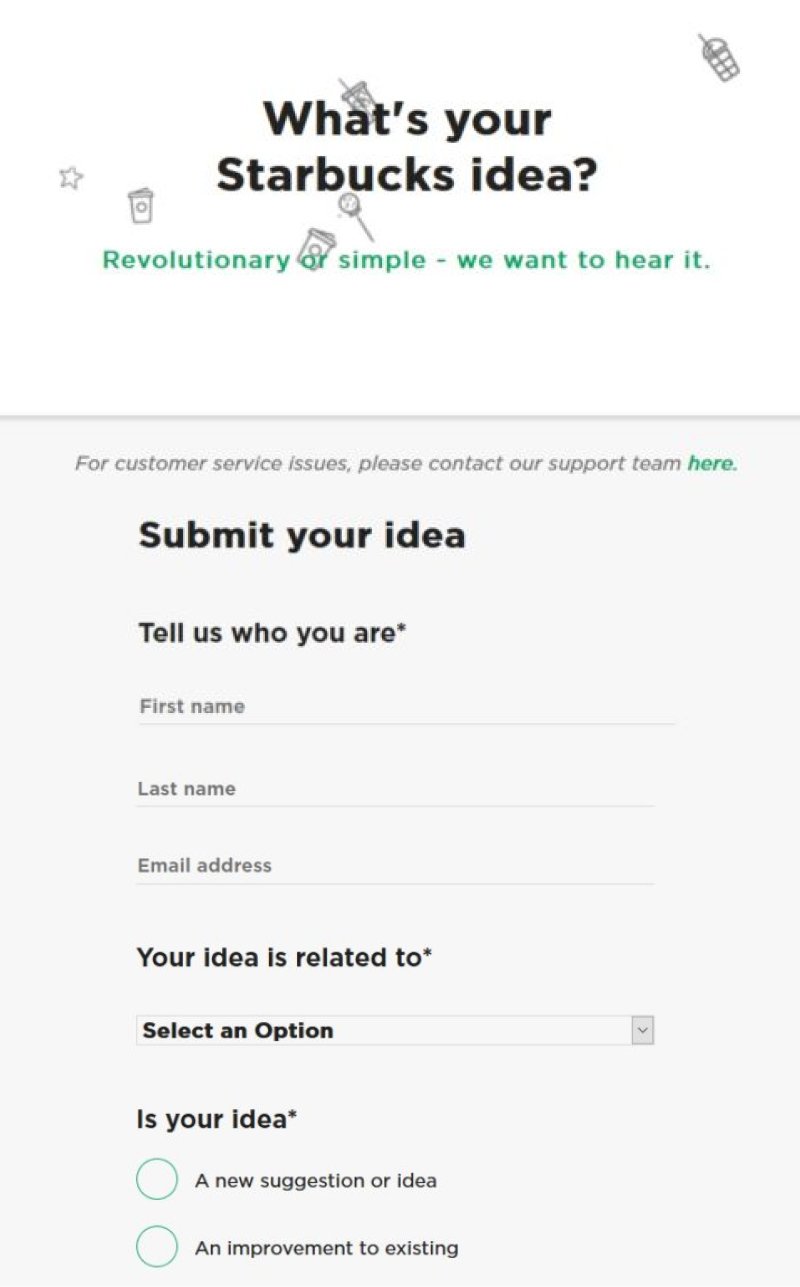
An interesting way to engage the audience, collect data, and do market research on the wants and needs of your customers. Here is a full video of this initiative:
Survey 2: Competitor research survey
Getting to know your competition might feel scary and intimidating, but by looking at the bigger picture, you will gain power and valuable perspective that will definitely help you in the long run.
Why do it: conducting such a survey will help you understand who your competitors are, how people perceive them against your brand/product/service, and how is your offer and price in comparison to your competitors, and ultimately help you with targeting new customers.
Competitor research survey examples:
- Have you heard of our company/brand?
- Have you purchased something from our company?
- If you did, how satisfied were you with your purchase? How long have you been a customer?
- If not, what was the reason?
- How likely are you to recommend our company to a friend?
- Have you heard of #name of a competitor?
- Have you purchased from #name of a competitor?
- What made you choose us over a competitor/ and vice versa?
- What do you wish our product/service had that it currently does not?
- What do you like most/least? How does your product/service fits into your workflow/meet your daily needs?
For example, the Swedish brand Happy Socks with e-mail marketing’s help and surveys are researching their competitors and the overall experience people had with purchasing on their website. To make their survey even more successful they are offering 25% off + free shipping.
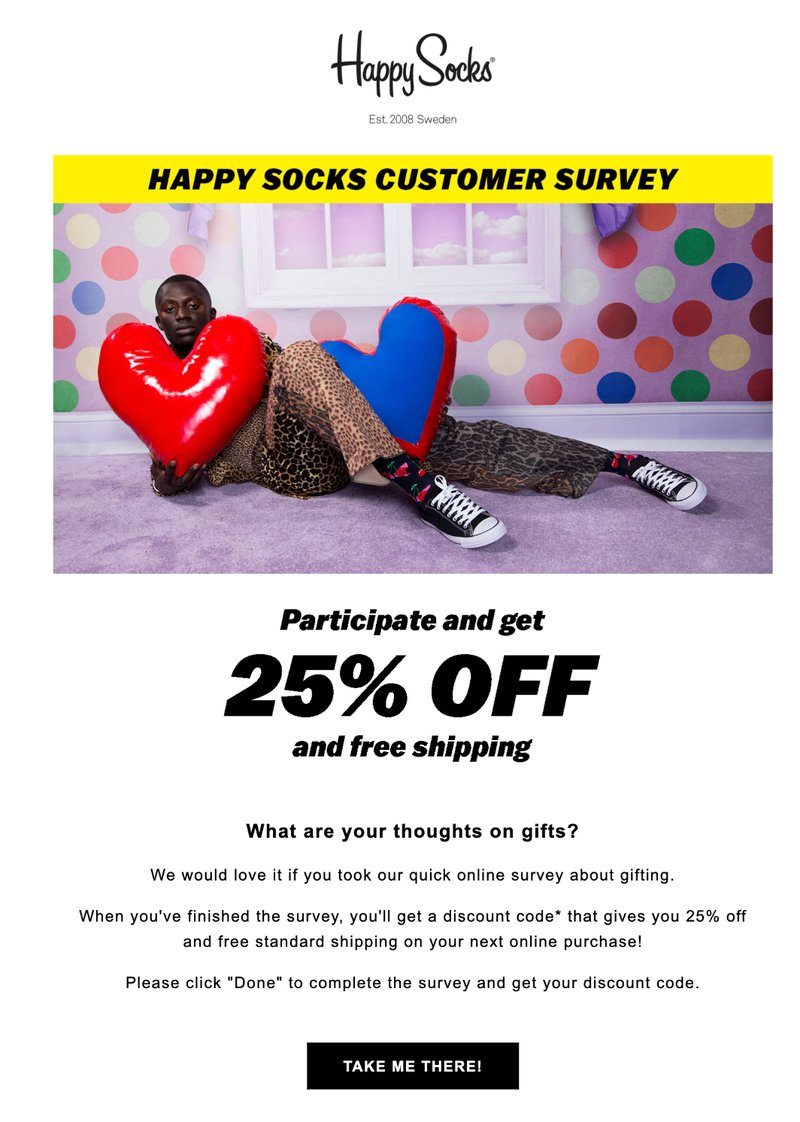
Other things worth looking into are: how are your competitors attracting customers, how well are their social media channels performing, how much website traffic do they have and from what type of sources, which keywords are they ranking for, and with what type of content. Helpful tools: Google Trends, Semrush, and AnswerThePublic.
Survey 3: Buyer persona / Customer analysis survey
In the marketing world, buyer personas are fictional individuals that represent your ideal customer.
It’s a Stock image next to an imaginary name, personal information and goals, life challenges and interests, work title, skills and experience, and most importantly, how you fit into their life (how your product incorporates into their lifestyle/ what problem does it solve).
Why do it: doing a detailed customer analysis with a marketing survey will help you understand your customers’ needs and problems and empathize with them; based on the data, you will be able to tailor your marketing efforts, understand purchasing decisions, get some behavioral insights, and create more targeted content for every channel.
“In my experience, creating buyer personas and getting to know our (potential) customers was a game-changer. It allowed us to strategically plan our entire content marketing strategy. Across all of our channels, we started personalising the message we wanted to convey, and the content that was being published. This helped us increase the engagement across all channels, increase our organic blog traffic with relevant visitors, and of most importantly increase our sales”.
Customer analysis survey examples:
- Demographic questions such as: What’s your age, gender, educational background, and career path?
- What are your interests and hobbies? What do you do in your spare time?
- What company do you work for/in which industry/ and a number of employees?
- What are your job title and main responsibilities? Whom do you report to, and who reports to you? How is your work measured?
- What are your biggest challenges (both professionally and personally)? What triggers you to find a solution?
- What tools do you use at your job?
- How are you using our product/service/software, and what are your main objectives with it?
- What is the most common reason you’re not buying a certain product?
- How do you learn about new information, and which blogs/publications do you read? What’s your favorite social network?
- How do you purchase things? How do you search for information? How would you describe your last purchase?
Helpful tools when it comes to creating Buyer Persona from your conducted survey: Make My Persona.
An effective marketing survey that will help you to understand customer behavior is to create a very detailed and in-depth feedback form. See the example by Chipotle:
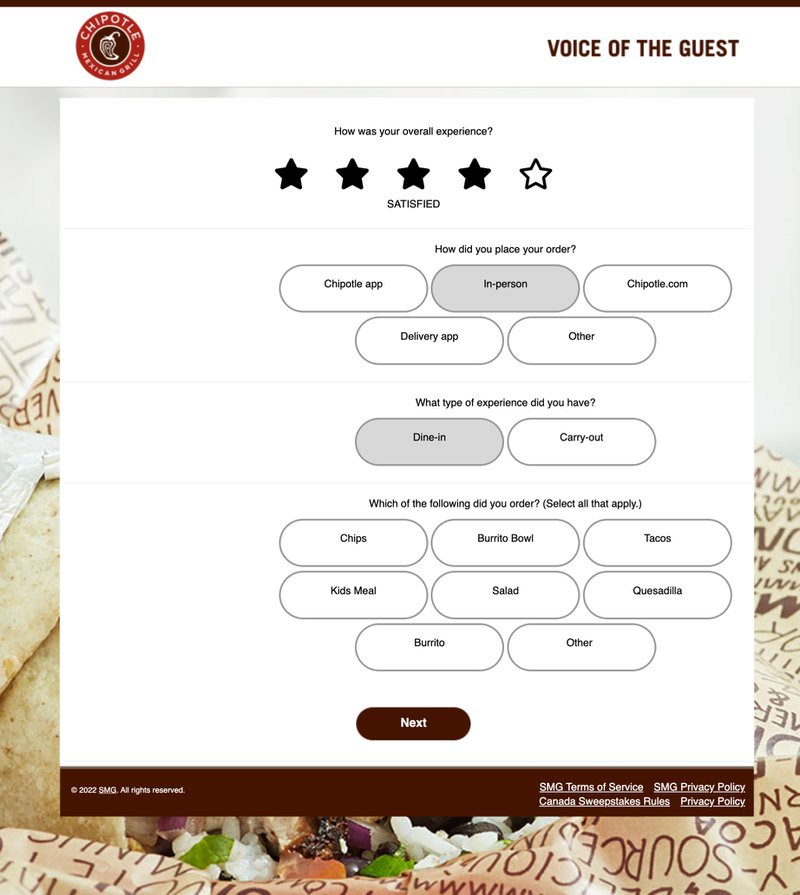
Survey 4: Brand awareness survey
How memorable is your brand? How well do your customers know your brand? How do your customers perceive your brand?
If you are looking into answering these questions and more, it’s about time you conduct a brand awareness survey.
Brand awareness is a combination of four things:
- brand recognition – how recognizable is your brand
- brand recall – how memorable is your brand, and how does your brand come to your customer’s mind
- brand identity – how well are your brand’s mission and vision understood
- brand image – the overall feel and opinion of your brand
Why do it? Getting to know how your customers perceive your brand will help you improve your positioning on the market and, therefore, help you grow your business and increase your brand awareness and sales.
Take, for example, the everlasting battle between Coke and Pepsi ? – it is no longer a who’s got a better taste kinda battle, but instead who’s got a more loyal community.
Brand awareness survey examples:
- Which brands do you most commonly purchase products from?
- Which of the following brands do you recognize?
- If #name of the brand was a person, how would you describe it? What’s your opinion on it?
- How did you find out about #name of the brand? How likely are you to recommend it to a friend or family?
- You have #a certain problem – what brand/company do you turn to?
- Which of the following statements do you associate with #name of the brand?
- How could we make you loyal to our brand? What’s crucial to you?
- What’s the first thing when you think of #name of the brand?
- When was the last time you used the #name of the brand?
- How familiar are you with our brand?
Here are more questions and a premade brand awareness survey template you can start using right now:
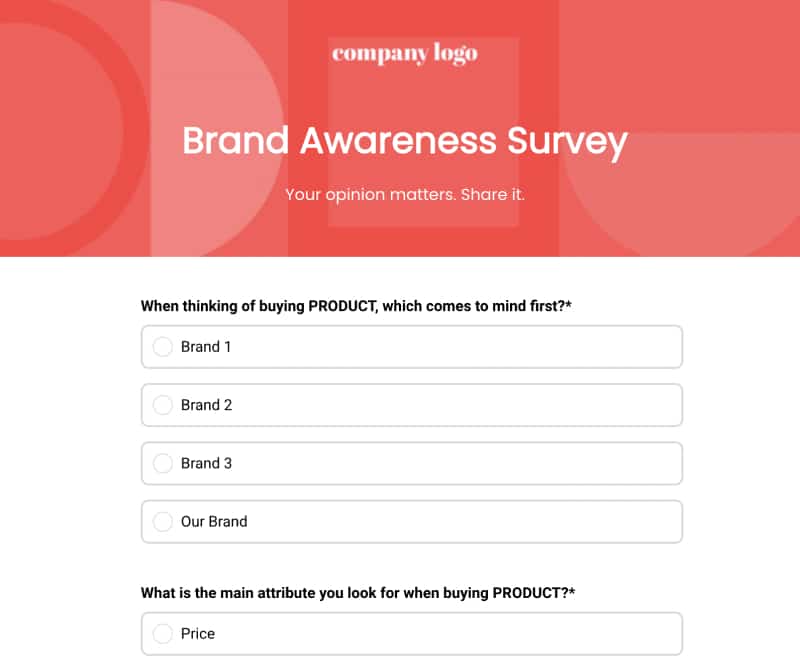
Survey 5: Product research survey
Launching a new product takes a lot of effort, money, and time but it also comes with a lot of uncertainty and fear of failure.
You never know whether the product will be a success or not, but there is something to do about your doubts – conduct a product research survey.
A product research survey can be both when launching a new product or when looking into improving an old one.
Why do it: it will help you evaluate your customer’s reaction and opinion regarding your new/improved product and, therefore, help you make better decisions about the product’s functionalities, features, and design.
Product research survey examples:
- How often do you use our product/service during the day/week/month?
- How long have you been using our product/service?
- How would you rate our product/service?
- What problems are you trying to solve with our product?
- What features are missing?
- Which features are most valuable to you?
- Which important features could be better/improved?
- How easy it is to use our product/rate on a scale from 0-10?
- How would you rate the value for money?
- Have you faced any problems while using our product/service?
For example, Alex Tooby wanted to make a pulse check of her audience to understand what kind of content (her type of product) they will want from her to create. It is a perfect marketing survey to see what her target audience needs so she can accommodate her services based on their actual needs.
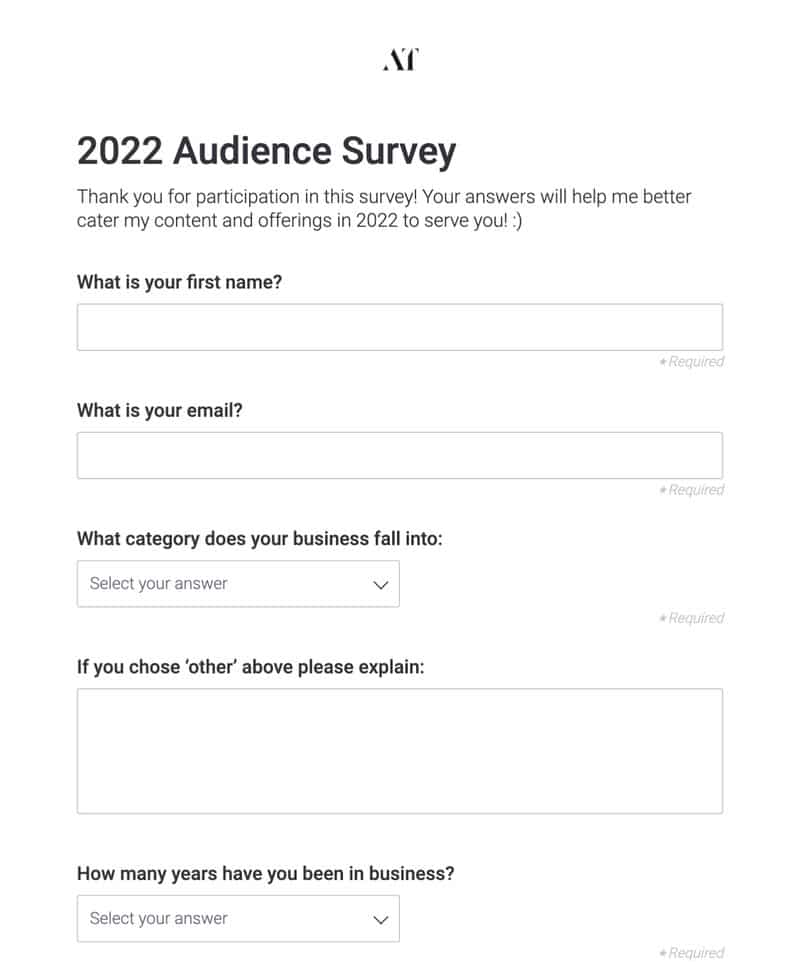
Steps to conduct a marketing survey
Now that you are aware of the most important types of marketing surveys, it’s only fair to move on to a practical step-by-step of how to conduct a single survey.
Step 1: Set a clear goal
Before starting to write those questions, think about a clear goal of why you’re doing the marketing survey.
Are you looking into expanding to other markets? Are you looking into creating and launching a new product or improving an old one? What exactly are you looking to find out by doing the survey?
Setting clear goals and intentions for the marketing survey will help you get the answers you need.
Step 2: Map out a workflow for the task
This is more of a technical thing to do – but nonetheless, it’s important. Make sure you establish a budget, choose what markets you want to survey, decide whether you’ll hire a market research company to assist you, and, based on your goals – choose what you’ll investigate.
Step 3: Choose a tool in which you’ll create the survey
Make sure you also put a lot of thought into how the marketing survey would look. You don’t want to overwhelm your target group with too many questions at once or have a survey with an inconvenient design.
Step 4: Collect and analyze the data, and lastly
Step 5: Take action
Based on your research findings and the initial goals, you can make a safe decision and choose a direction in which you want to “move”.
Free Marketing Survey Tools
Now that we’ve gone over every how and why, the only thing remaining are the tools with which you can create these surveys, and here are some free options:
- Google Forms – free, fast, and it even automatically saves your results to a Google Spreadsheet so you can analyze your results. There are versatile options for long and short answers, multiple-choice selections, dropdown options, the ability to add both images and videos, create your form as a quiz, etc.
- Microsoft Forms – favoring Microsoft over Google, Excel over Google Sheets? If so, do go with this form builder. It’s free, simple, and connected with Excel, which has more powerful data analytics functionalities.
- Jotform – is another free online survey builder which is most known for its huge forms library with approximately 10,000 surveys. The first five forms are free (everything above – they are charging $24 per month).
- EmbedForms – is an innovative solution that will not only help you create forms but also help you to transform those forms into widgets for your website. Besides being forever free, this builder tool is packed with helpful features such as an advanced drag and drop editor, conditional logic options to create a certain flow of your form, and an easy way to share your marketing survey results.
If you’re looking for more alternatives – here’s a list with more than 25+ Form Builder Tools.
Conclusion
Using surveys is an affordable and effective way to get valuable insights both for the market and your customers, so do make sure to make the most of it!
Now you have all the information needed, so there’s no need to spend additional time searching for the right questions; instead, you can only focus on getting that customer feedback and making better decisions based on data.

